TieDowns for Your Mobile Home When severe weather hits and strong winds blow, your mobile home needs extra protection to ensure a safe, anchored space Mobile homes are more susceptible to flipping and incurring other damage during heavy winds, so no matter where you live, tiedowns and anchors are necessaryTie downs for mobile homes, trailers, doublewides are usually expected to be placed and connected according to details provided in the mobile home installation manual (have you ever seen one?) If you know your mobile home or trailer model name and perhaps serial number, you may be able to contact the mobile home manufacturer to ask for an installation manualMobile Home Tie Downs and Straps UnderHome Armor will determine which type of mobile home tie down and straps are required in your area Many of the older mobile homes require that straps must go completely over the top of the mobile home to securely strap it down New mobile homes don't require the straps to go completely over the home because of the newer mobile home's

Mobile Home Tie Downs Anchors Stabilizing Systems Defects Commonly Found In The Stabilizing Systems Cables Tie Downs For Wind Storm Damage Resistance Of Mobile Homes Doublewides Mutiwides Trailers
Tie downs for mobile homes when required
Tie downs for mobile homes when required-Mobile Home tie Downs will stabilize and protect your mobile home during high winds and storms They also stabilize your mobile home after it has been anchored down and helps to keep your mobile home level Mobile homes can be damaged during our violent thunderstorms and hurricanes in Florida You must install mobile home tiedowns to keep your home stable during wind events and storms Mobile homesThis process is known as tying down a mobile home, and it's a relatively easy way to make sure you're safe inside you're mobile home Just follow these steps 1 Decide Which TieDown Method to Use Older mobile homes require "overthetop" tie downs that stretch over the entire structured However, newer mobile homes come with pre




Mobile Home Tie Downs Anchor Your Home During Storms Tri Cities
TieDown Anchoring Systems are REQUIRED Mobile homes should ALWAYS be tied down In fact, Washington State law requires manufactured home owners to secure their homes using approved anchors and tiedowns Homes without proper tiedowns are more vulnerable to high winds Taking proper precautions now will ensure that your mobile home is properly secured, reducing possible damage to your home Tiedowns are systems of heavyduty straps and anchors designed to stabilize manufactured homes (also known as mobile homes) during high winds Manufactured homes are more easily flipped or damaged during windstorms than sitebuilt homes and they require tie downs to remain stableWe decided to research how mobile homes are installed to ensure the building will b
Tiedowns are systems of heavyduty straps and anchors designed to stabilize manufactured homes (also known as mobile homes) during high winds Manufactured homes are more easily flipped or damaged during windstorms than sitebuilt homes and they require tiedowns to remain stable(3) (a) Longitudinal Tiedowns All new and used mobile/manufactured homes, installed sixty (60) days after the effective date of this rule, must have longitudinal tiedowns or other approved longitudinal stabilizing systems designed to resist horizontal wind loads in the long direction of the home (ie wind load applied to each end of the home) The longitudinal tiedowns are in addition Manufactured home tiedowns are systems of heavyduty straps and anchors designed to stabilize manufactured homes (also known as mobile homes) during high winds Failure to properly install and maintain tiedowns results in
Tie down requirements for a mobile home mobile home anchors how they work manufactured home site prep soil how to finance a mobile or manufactured mobile home anchors how they workMobile Home Tie Downs And Hurricane AnchorsWhat Are The Tie Down Requirements For A Mobile HomeMobile Home Anchors How They Work Methods Diy AndMobile Home Tie Downs are extremely Important for your family's safety if you live in a mobile home Underhome Armor will determine which type of mobile home tie down and straps are required in your area Many of the older mobile homes required that the straps must go completely over the top of the mobile home to securely strap it down, while new mobile homes don't require Because single wide mobile homes are more likely to be affected by high winds, they will require both diagonal and vertical tiedowns Whereas a double wide only requires diagonal tiedowns Whereas a double wide only requires diagonal tiedowns




Tie Down Anchors For Mobile Homes Types Installation
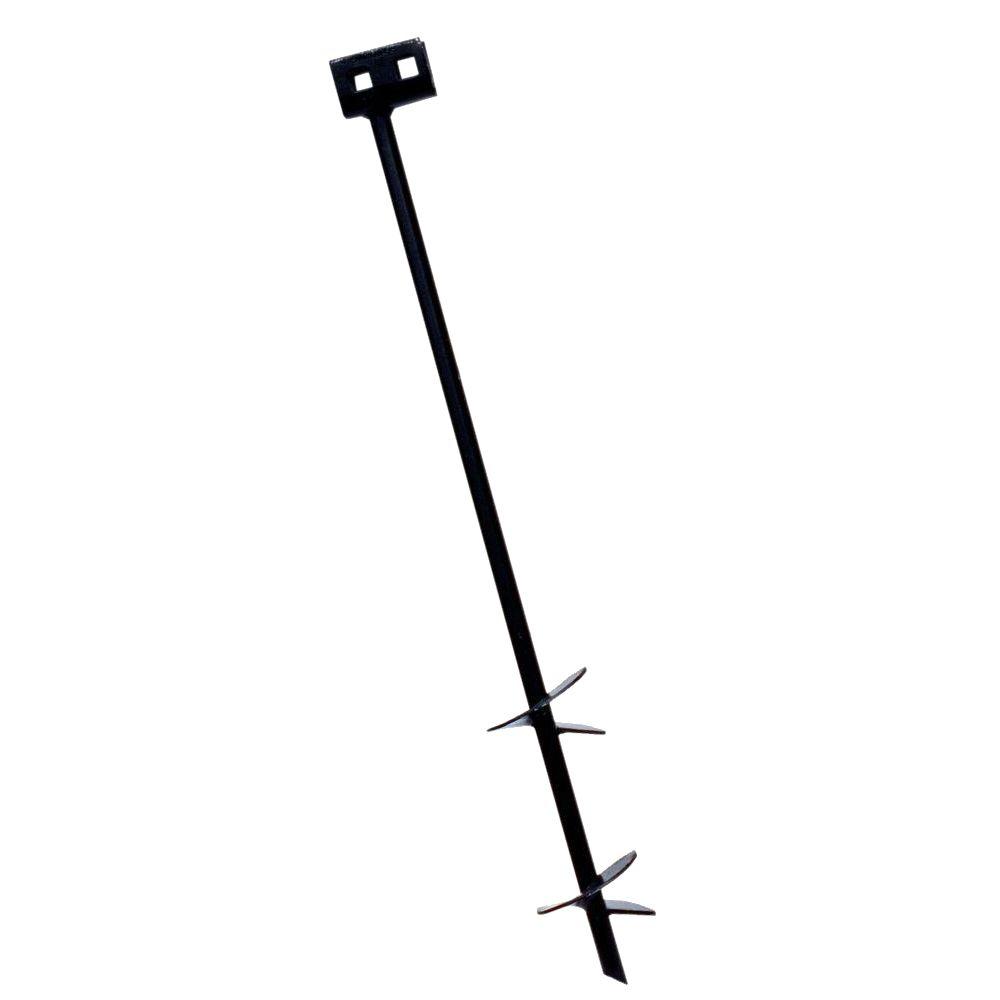



Tiedown Anchor Mh Mi223 4 l The Home Depot
What Is a Mobile Home Tie Down?The number of diagonal tie downs range from three to five per side in less storm danger areas In coastal areas, four to seven per side are used to serve the greater need For singlewide homes, vertical ties (on the roof area) required are two to four, depending on the length of the home How Earthquake tie downs for mobile homes tie downs contractor washington mh 35 ft mobile home strap in the mobile home anchors tie downs why your mobile home is shaking andMobile Home Tie Downs Underhome ArmorMobile Home Tie Downs Fl Anchor And BarrierManufactured Home Tie Downs Advane Inspection ServiceMobile Home Anchors How




Mobile Home Parts Anchors Tie Downs One 8 Pack Of Augers 30 Ebay
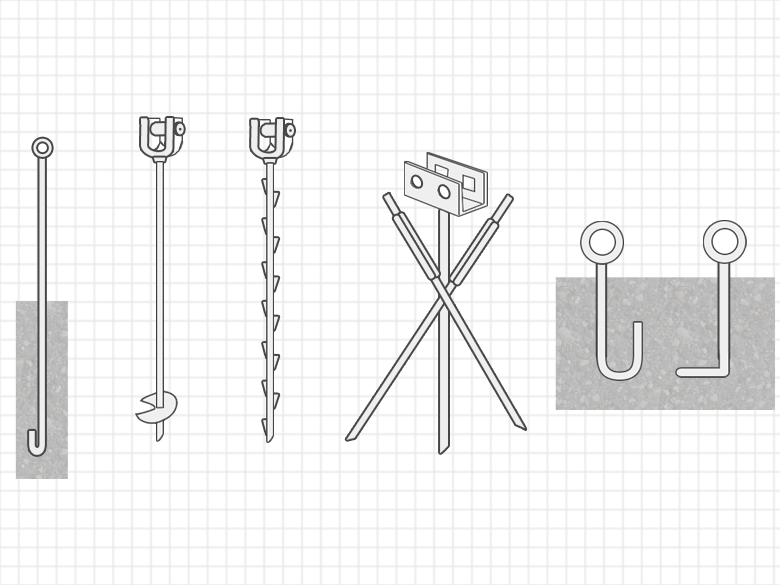



Mobile Home Anchors How They Work Methods Diy And More Mobile Home Repair
Types of Mobile home anchors and tie downs Engineered TieDown System (ETS) Engineered tiedown systems are primarily required to resist wind forces, but nonetheless, it also resists earthquake shakingTop priority for us, after delivery, was getting this shed strapped down!Tiedowns are systems of heavyduty straps and anchors designed to stabilize manufactured homes (also known as mobile homes) during high winds Failure to properly install and maintain tiedowns results in reduced capacity to resist sliding and overturning



Fha Compliant And Non Compliant Mobile Home Anchors
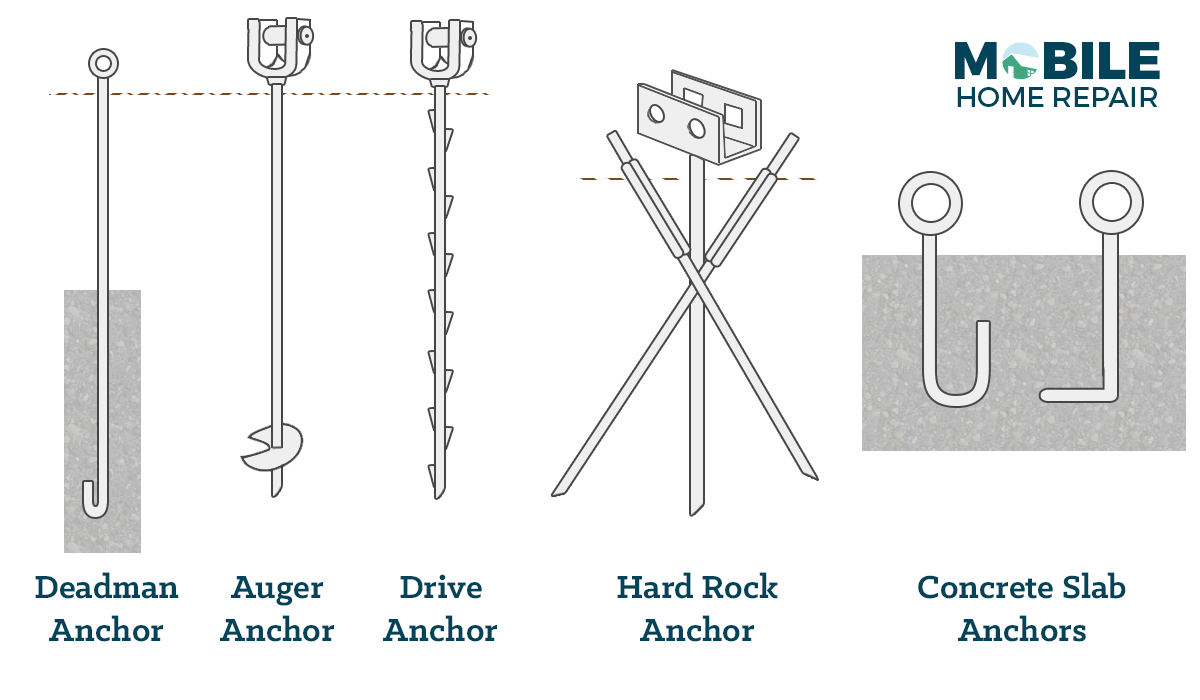



Mobile Home Anchors How They Work Methods Diy And More Mobile Home Repair
Tie downs @ 4 corners & not more than 40 iapart option b strip footings 2'x10'x8"deep concrete pads 8'0"o/c poured in place with tie downs as required 51de view outline of mobile home above , tie downs @4 corners & not more Homes dated pre08 may be required to meet the new tiedown standards for safety reasons, and legal/lender standards would apply in such cases If the lender is requiring tiedowns to be updated as a condition of loan approval or if the appraisal requires it, that's basically the last word on the subjectThe Mobile Homes The Same Training Required For All Licensed Home below is a part of Mobile Home Tie Downs Collection Gallery This digital photography of Mobile Homes The Same Training Required For All Licensed Home has dimension 640 × 414 pixels You can see a gallery of Mobile Home Tie Downs below And if you think that this image are interested to share with your




What Are Hud Laws Regarding Mobile Homes Us Mobile Home Pros
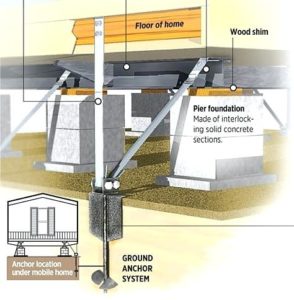



Hurricane Anchors Fl Anchor And Barrier
Arizona requires all mobile homes to have groundanchored tiedowns Economy sometimes brings a cost, and the freestanding mobile home in Arizona comes with requirements for a "tiedown" The manufactured home, built to US Department of Housing and Urban Development (HUD) standards, is less expensive than the cost of conventionally building a house For instance, additional anchors and straps may be required along your marriage line wall if you have a double wide or triple wide home If your home comes with a porch, some of the porch's posts will also be tied down And those are the basics of how a manufactured home is tied down to protect the home against wind forces for safety mobile homes required the use of more tiedowns Today, a typical manufactured home might have as many as 45 tiedowns compared with just 10 for a preAndrew manufactured unit Most damage that was observed was related to the loss of attached carports, the impact of windborne debris, or siding failure The summary statements published by the MHI stated "Overall, performance of homes
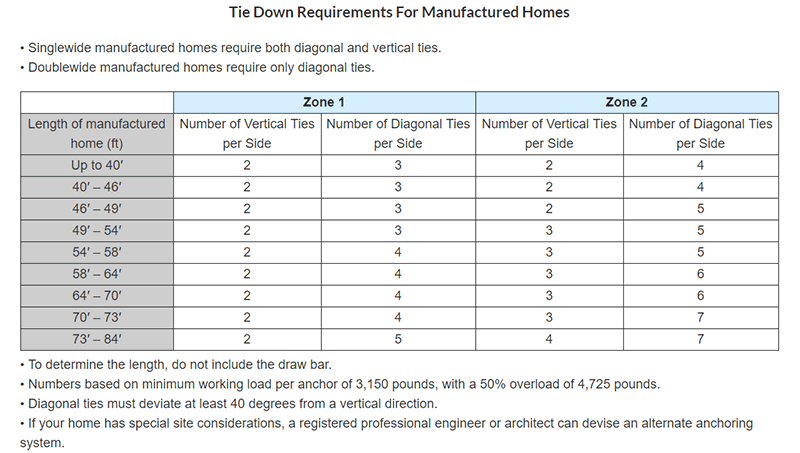



Mobile Home Anchors How They Work Methods Diy And More Mobile Home Repair
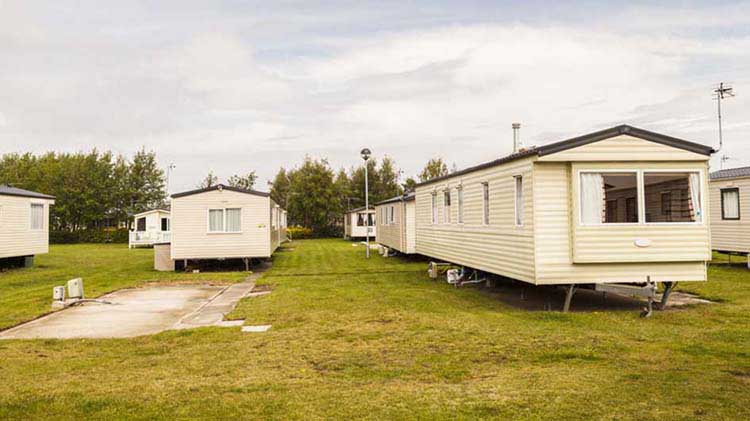



Manufactured And Mobile Home Safety State Farm
Mobile home tie downs are anchors or straps that are strong enough to keep the home secure during high winds A certain number of tie downs are required, and they are required to be spaced a specific distance apart After Hurricane Andrew ripped through Florida in 1994, requirements for mobile homes became much stricter Since then tie downs need to beWhen these straps are installed during the mobile home's fabrication, however, they can be integrated into the structure of the home (ie, the roof or siding) and thereby appear more hidden An additional disadvantage is that tie down straps must also be arranged in a way so that they're not blocking any windows or doors Frame Tie DownsTo combat the force of winds, two types of tie downs are used A vertical tie is used over the roof of a singlewide home to combat wind damage A diagonal tie down is used to tie the frame down to the ground This combats winds from lifting up the home Singlewide homes require both types of tie downs Due to weight factors, a doublewide mobile home only requires the diagonal tie down to anchor the home
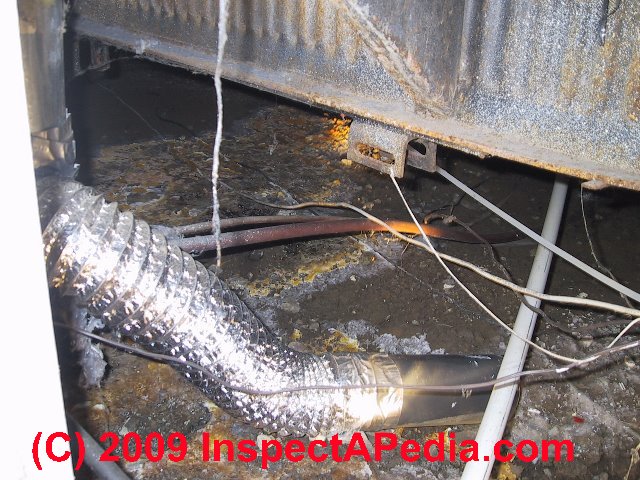



Mobile Home Tie Downs Anchors Stabilizing Systems Defects Commonly Found In The Stabilizing Systems Cables Tie Downs For Wind Storm Damage Resistance Of Mobile Homes Doublewides Mutiwides Trailers
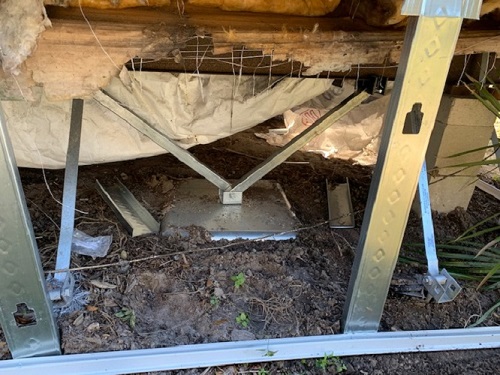



Mobile Home Engineering Foundation Certs 407 535 3195
The longitudinal tiedowns are in addition to the anchoring systems required along the exterior side walls and/or marriage walls of the mobile/manufactured home 298 (a) When anchors and straps are used for stabilizing the home in the longitudinal direction the strap must connect to a clip welded onto the Ibeam or other device connected mechanicallyInstallation Standards for Anchors and Tiedowns 15C Testing Specifications for Straps, Piers, Anchors and All Components 15C Pier Specifications 15C Strap/Cable Test Specifications 15C Anchor and Anchor Component Test Specifications 15C Manufacturer Quality Assurance Program and Monitoring 15C Rule Review 15C 2Mobile Home Tie Down Inspection Manufactured homes can often cause problems for homeowners, who are not aware of the laws that apply to them People often buy these convenient houses and then struggle to maintain them properly due to lack of knowledge A manufactured home is simply a caravan which is permanently installed at a
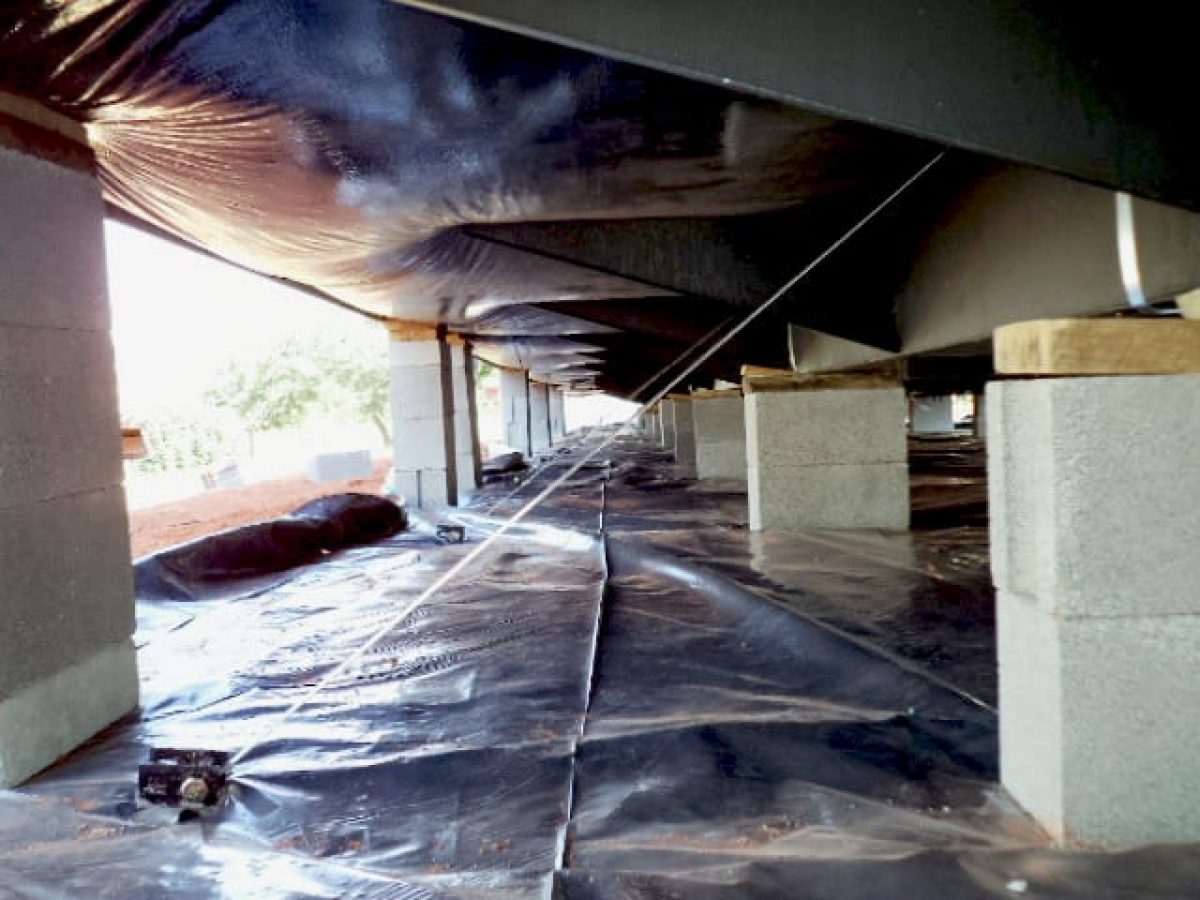



Manufactured Home Tie Downs Duraskirt For Life



Mobile Home Anchors Tie Downs Harris Reed Seiferth Insurance Group
Tiedowns are an essential part of the foundation system engineered for all mobile/manufactured homes Homes without proper tiedowns are less resistant to high winds Take the necessary precautions to ensure your mobile/manufactured home is properly secured Have your mobile/manufactured home tiedown system checked today by aBelow are 16 best pictures collection of Mobile Home Tie Downs photo in high resolution Click the image for larger image size and more details 1 Crawl Space Tie Down Connection Structure Stem Wall 2 Manufactured Home Foundation Engineering Certification 3 Correspondingly, how many tie downs are required for a mobile home?




Mobile Home Tie Down Inspection Waypoint Property Inspection
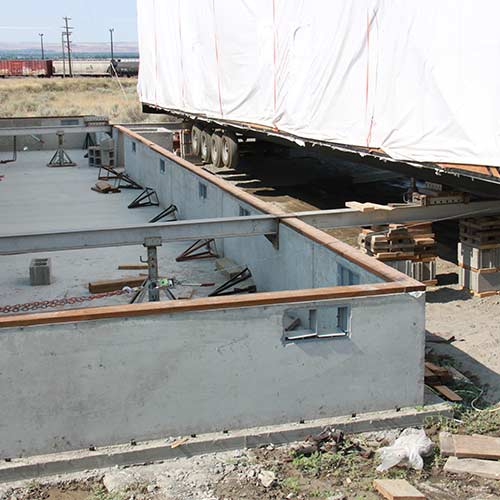



Mobile Home Tie Downs Anchor Your Home During Storms Tri Cities
Tiedowns are systems of heavyduty straps and anchors designed to stabilize manufactured homes (also known as mobile homes) during high winds Failure to properly install and maintain tiedowns results in reduced capacity to resist sliding and overturningTIE DOWNS All mobile homes placed in migrant camps after , must have tie downs or anchors Tie downs must be installed in compliance with the manufacturer's specifications In the absence of the manufacturer's specifications, we suggest the owner contact the manufacturer for the specifications Tie downs must be anchored to a foundation thatMobile Home Tie Downs photos and pictures collection that posted here was carefully selected and uploaded by HouseTardis Homes Designs and Ideas Staff after selecting the ones that are best among the others So, finally we make it and here these list of great photos and images for your inspiration and informational purpose regarding the Mobile Home Tie Downs as part of Juara Homes




Understanding Mobile Home Tie Down Requirements




Mobile Home Tie Downs Anchors Stabilizing Systems Defects Commonly Found In The Stabilizing Systems Cables Tie Downs For Wind Storm Damage Resistance Of Mobile Homes Doublewides Mutiwides Trailers
Like a commercial building, manufactured/mobile homes are constructed using structural steel The steel is secured to the wood joists and plywood flooring so they can be safely transported on the roadways Once delivered and set up the homes need tiedowns secured to the structural steel to the earth There are various ways to accomplish this and one is the use of tiedowns, tiedownsMobile Home Tie Down We are Engineers that provide foundation certifications on mobile home tie down systems and other manufactured home components in accordance with FHA/HUD guidelines We help you out when you are selling (or buying) your manufactured home by providing you with an Engineer's Foundation Certification225 Based in part on this document, HUD is required to prepare a final MIS for use by the states as a minimum baseline when writing their own installation standards (as required by the MHIA) The final MIS must also function as a minimum baseline for manufacturers in preparing the Manufacturer's Installation Instructions (MII) required for



Tying Things Down Properly With Mobile Home Anchors Star Supply Usa
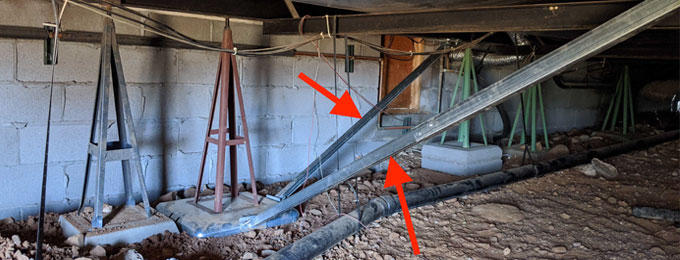



Manufactured Home Tie Downs Advantage Inspection Service
Mobile Home TieDowns 14 products Stay grounded during weather events with Star Supply's collection of mobile home tiedowns Tiedown systems for manufactured homes consist of straps and anchors to secure your living unit to its foundation when the wind intensifies The type of mobile home anchor you need depends on your foundation — use Definition of Earthquake TieDowns for Mobile Homes Worrying about living in a manufactured home or mobile home in highwind or seismic events is common But securing them for these destructive forces by tying them down properly relieves concerns Especially, when you educate yourself on how earthquake tiedowns for mobile homes work As you may know, theA mobile home tie down is a metal strap that comes from the footings of the structure and wraps into the structure of the mobile home This prevents uplift of the mobile home during a high wind event It is quite common for these tie downs to become damaged and corroded overtime Moreover, they could also be improperly installed This is why FHA and VA mortgage loans require inspections on mobile home tie downs



Fha Compliant And Non Compliant Mobile Home Anchors



35 Ft Mobile Home Strap In The Mobile Home Hardware Department At Lowes Com
Securing your home with mobile home tiedowns is one of the best ways to prevent it from toppling over during heavy winds While the cheaper, doityourself straps claim to be sufficient, there is no adequate substitution for professionally installed tiedowns The looks of the cheaper straps also leave a lot to be desired, and many homeowners complain of the unsightly strap that Single and doublewide mobile homes both require diagonal tiedowns Singlewide homes are more vulnerable to the lateral (sideways) wind forces due to their narrow width, so they also need vertical tiedowns These overthetop straps will be a visible wrap in older singlewides The number of tiedowns required is dependent on two criteriaTieDown (Anchor) Requirements All mobile/manufactured homes are required to be tied down in accordance with the specifications provided by the manufacturer In the case of a used home, and in the absence of the manufacturer's tiedown instructions, the home must be tied down in accordance with the
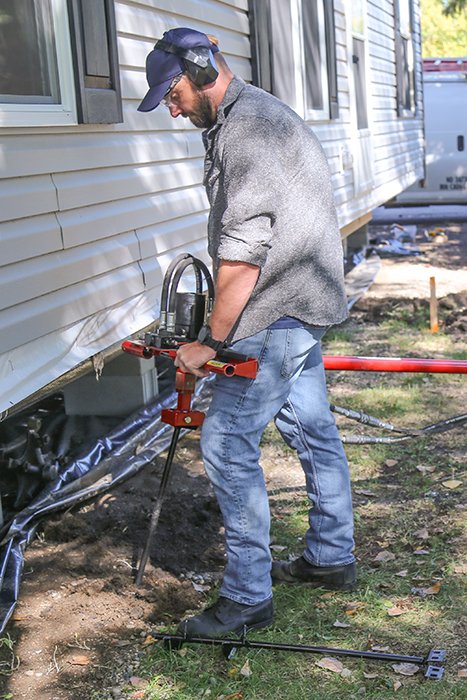



Anchoring Little Beaver




Mobile Home Anchors Tie Downs Diagrams Charts Mobile Home Repair Mobile Home Home Repair
To resist wind forces, you need two different types of tiedowns In older homes, a vertical or overthetop tiedown is needed to compensate for the uplift force A diagonal or frame tiedown is needed to compensate for both lateral and uplift forces Singlewide manufactured homes need both types of tiedowns Doublewide homes only need the diagonal ties If you require any help or advice about Mobile Home Longitudinal And Lateral Stabilizer Devices send us a message on the contact page or give us a call on 863 808 Categories Home Improvement s anchors , lateral , longitudinal , lsd , lsd2 , minuteman , Oliver systems , stabilizer plates , XI systems , xis Post navigation




How To Check Your Manufactured Home S Hurricane Tiedowns Youtube




Mobile Home Tie Downs Fl Anchor And Barrier




How Manufactured Homes Are Tied Down L Clayton Studio
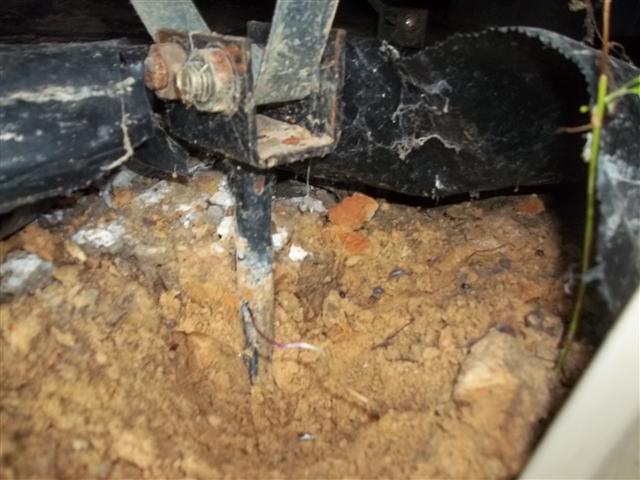



Fha Compliant And Non Compliant Mobile Home Anchors
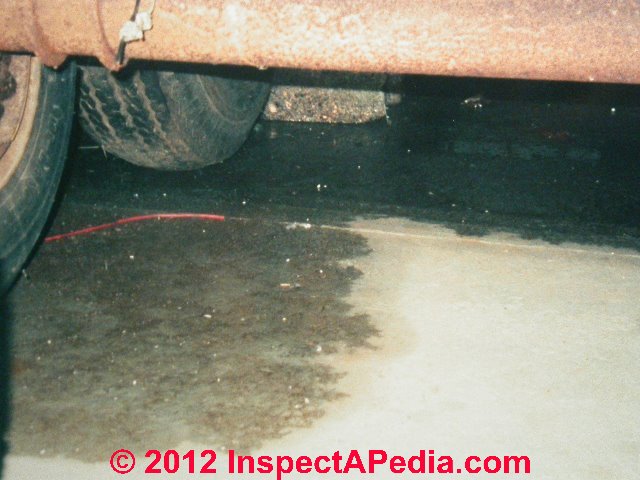



Mobile Home Tie Downs Anchors Stabilizing Systems Defects Commonly Found In The Stabilizing Systems Cables Tie Downs For Wind Storm Damage Resistance Of Mobile Homes Doublewides Mutiwides Trailers



Gleeson Mobile Home Service Tie Downs Anchoring




Foundation Inspection Requirements Cost For Manufactured Homes
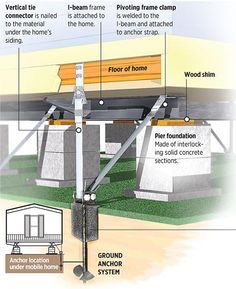



Winterizing Your Manufactured Home And Save Manufacturedhomelivingnews Com



1



Mobile Home Anchors Tie Downs
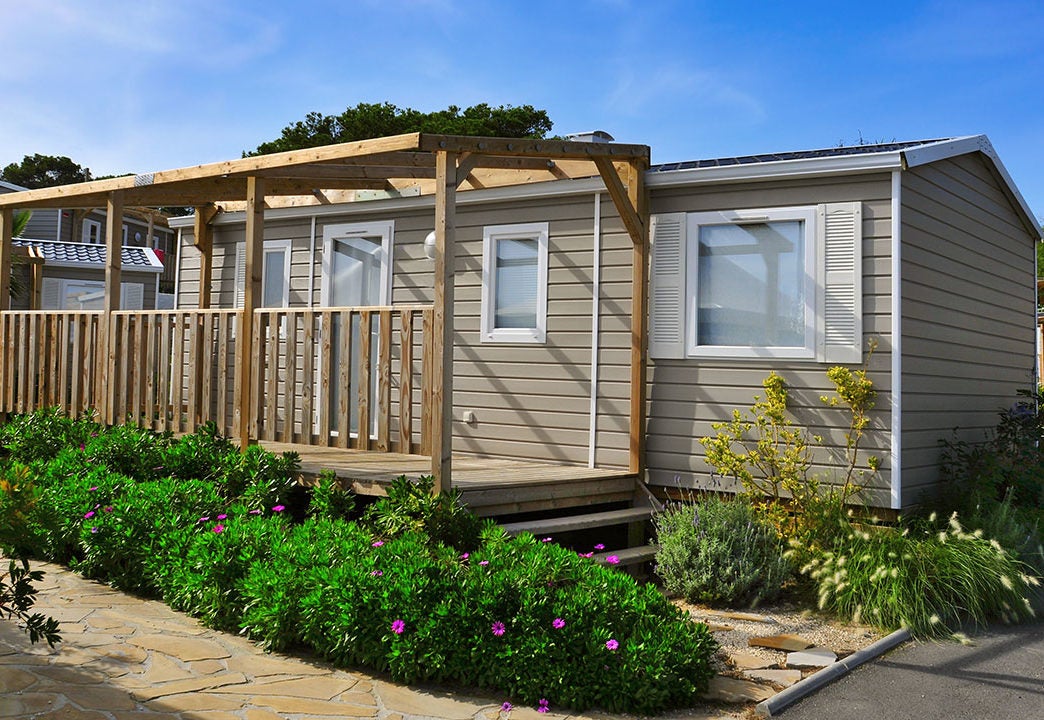



How To Finance A Mobile Or Manufactured Home Bankrate




Fha Manufactured And Mobile Home Guidelines Fha Lenders
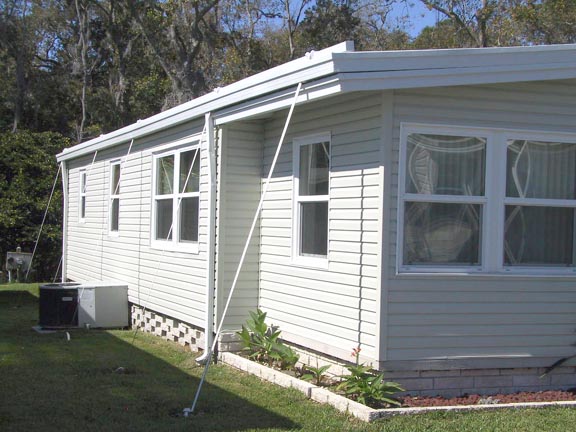



Mobile Home Anchors How They Work Methods Diy And More Mobile Home Repair




Mobile Home Tie Down Program Youtube
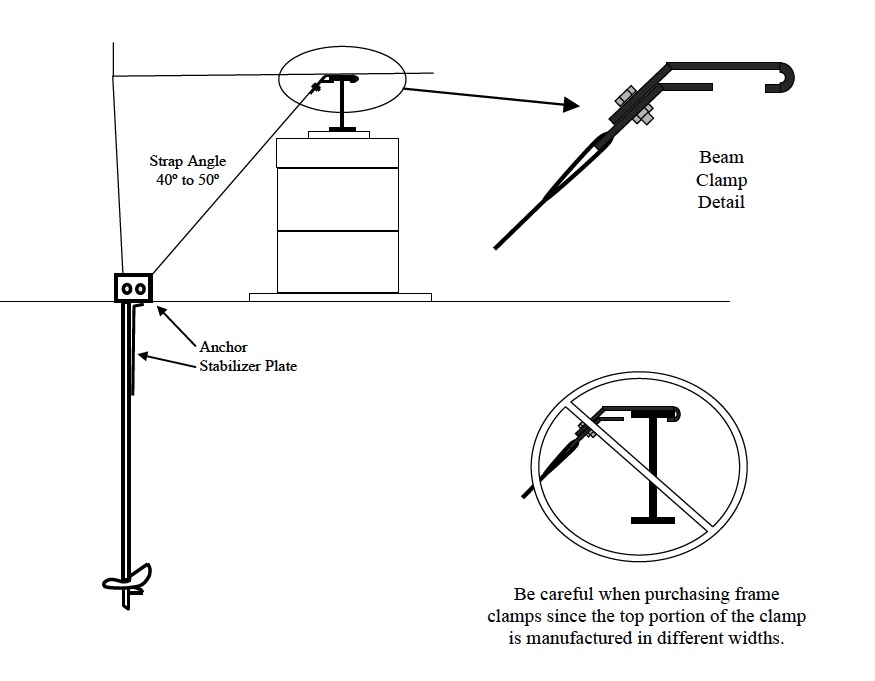



What Is The Maximum Spacing For Mobile Manufactured Home Tie Downs In Florida




Mobile Home Tie Downs Anchor Your Home During Storms Tri Cities




Pros And Cons Of Manufactured Homes As Housing Options The Ultimate List Homes Direct
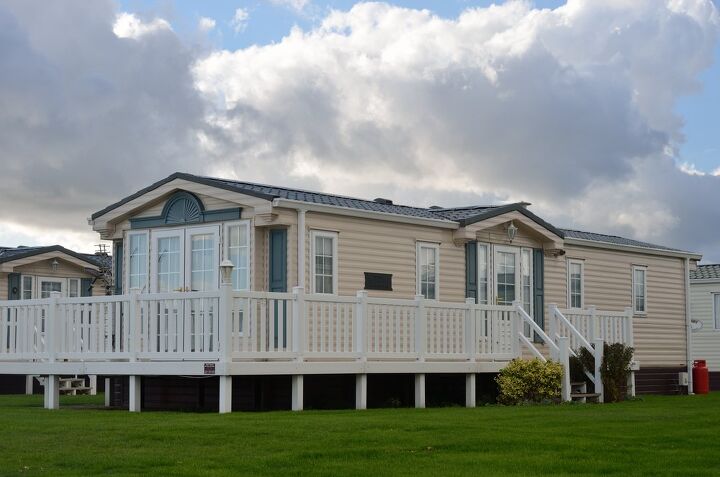



How Much Does It Cost To Put Tie Downs On A Mobile Home Upgraded Home




Definition Of Permanent Foundation On Mobile Home Structural Inspections Internachi Forum
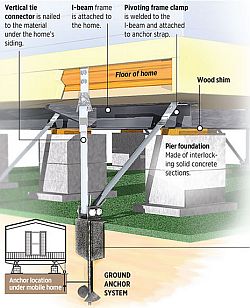



Mobile Home Tie Downs And Hurricane Anchors




Fha Compliant And Non Compliant Mobile Home Anchors




Things To Consider When Purchasing A Mobile Home The A Team




Mobile Home Anchors How They Work Methods Diy And More Mobile Home Repair
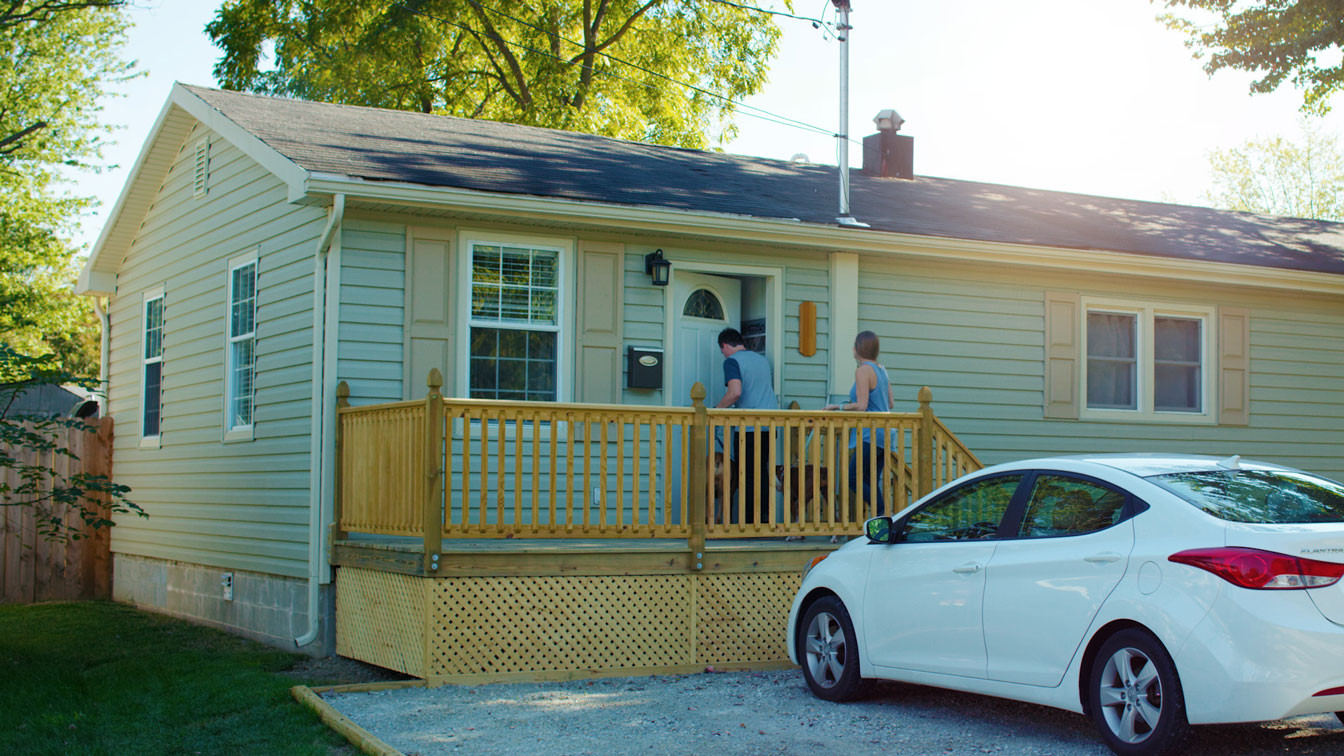



Tie Downs Are Crucial For Manufactured Homes American Modern Insurance Agents
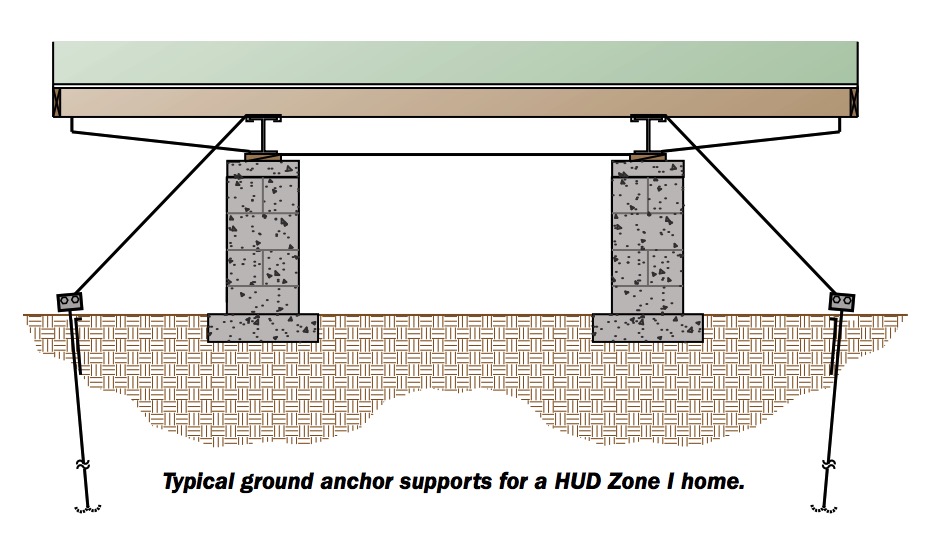



What Are The Tie Down Requirements For A Mobile Home



Need Of Manufactured Home Anchors And Tie Downs




How To Properly Anchor A Shed The Only Guide You Need




How To Install Tie Downs And Anchors Pages 1 4 Flip Pdf Download Fliphtml5




Selling Modular Prefab Not Double Wide Type Bestofhouse Net
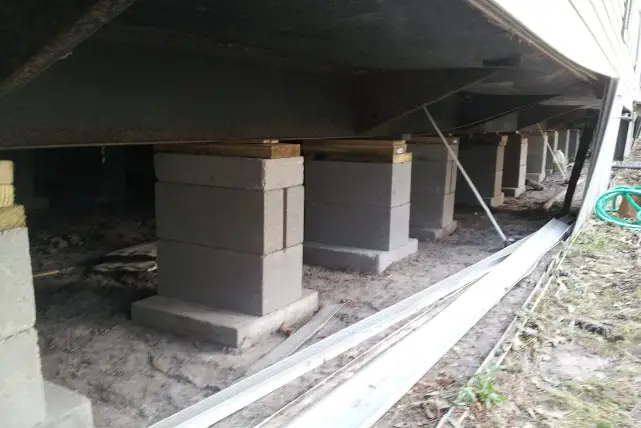



The 12 Most Common Problems With Older Mobile Homes Mobile Home Friend
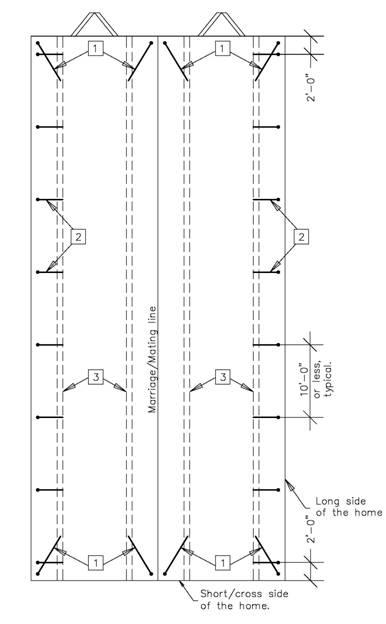



Manufactured Homes Pse Consulting Engineers Inc
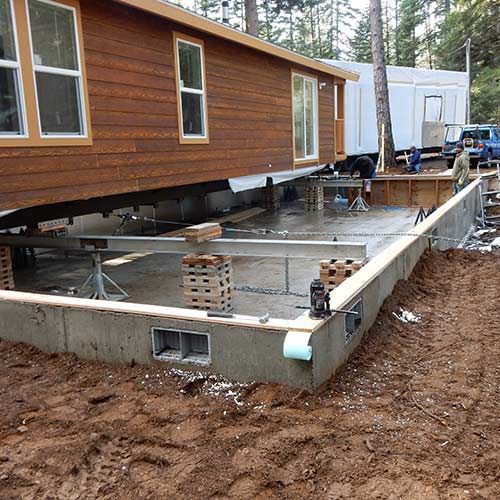



Mobile Home Tie Downs Anchor Your Home During Storms Tri Cities




Mobile Homes Small Houses Big Challenges Fire Engineering




Mobile Home Parts Set Of 4 Wet Concrete J Hook Anchors For Use With Tie Down Straps Amazon Com
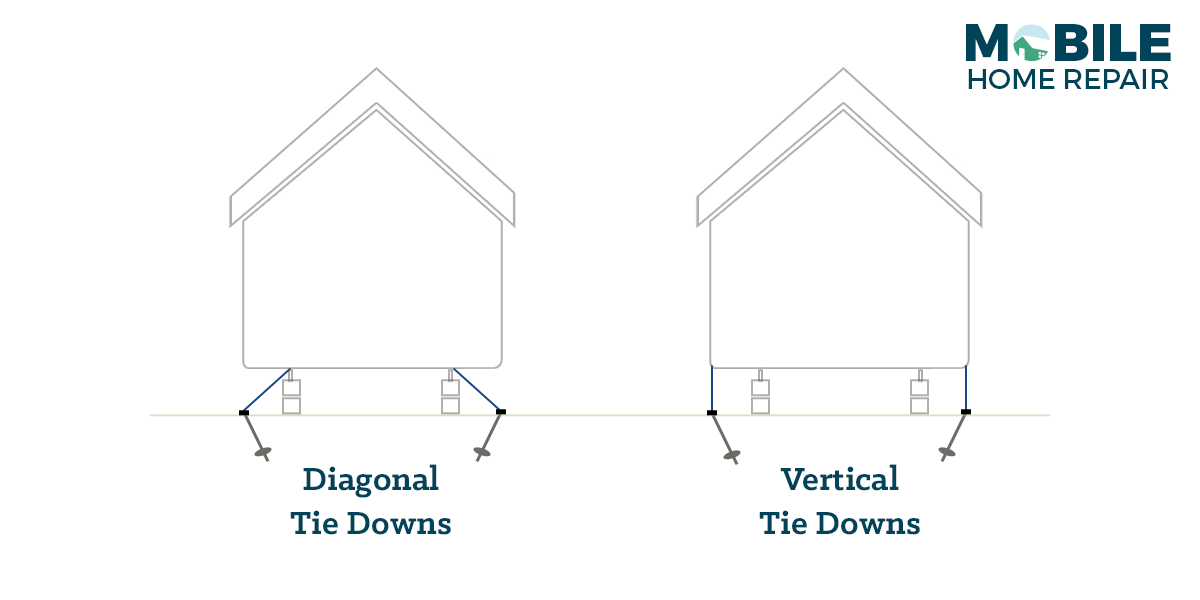



Mobile Home Anchors How They Work Methods Diy And More Mobile Home Repair




30 In Mobile Home Anchor In The Mobile Home Hardware Department At Lowes Com
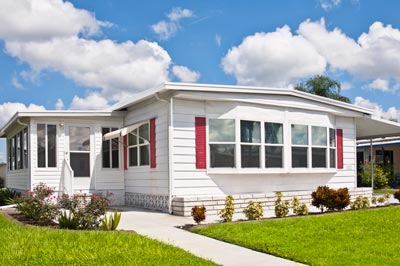



Mobile Home Anchors And Tie Downs Foremost Insurance Group




Mobile Home Tie Downs Fl Anchor And Barrier



Shed
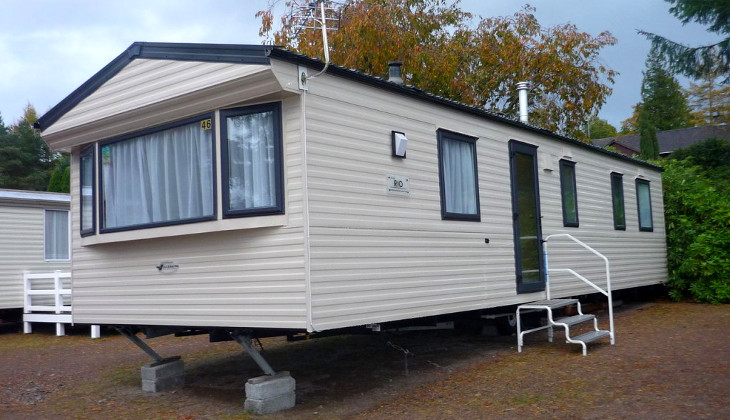



Mobile Home Anchors Enabling Your House To Stand Its Ground Against Natural Disasters




How To Inspect Manufactured And Mobile Homes Online Course Student Discussions Internachi Forum
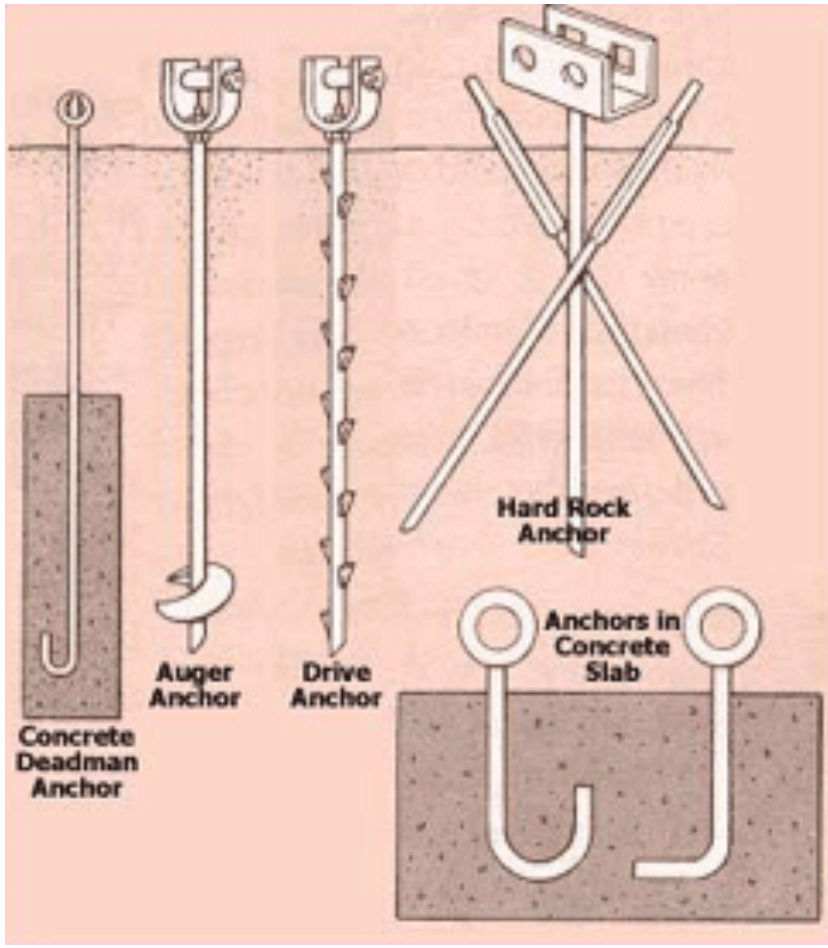



Mobile Home Tie Downs Anchors Stabilizing Systems Defects Commonly Found In The Stabilizing Systems Cables Tie Downs For Wind Storm Damage Resistance Of Mobile Homes Doublewides Mutiwides Trailers



Mobile Home Advantage



Earthquale Bracing For Manufractured Homes Home Tie Downs




Manufactured Home Installation And Setup Mobile Home Living



Hurricane




Piezas De Casas Moviles Anclajes Amarres Uno 4 Paquete De Barrenas 30 Ebay



Xi2 Concrete Foundation System Star Supply Usa




Tie Down Anchors For Mobile Homes Types Installation
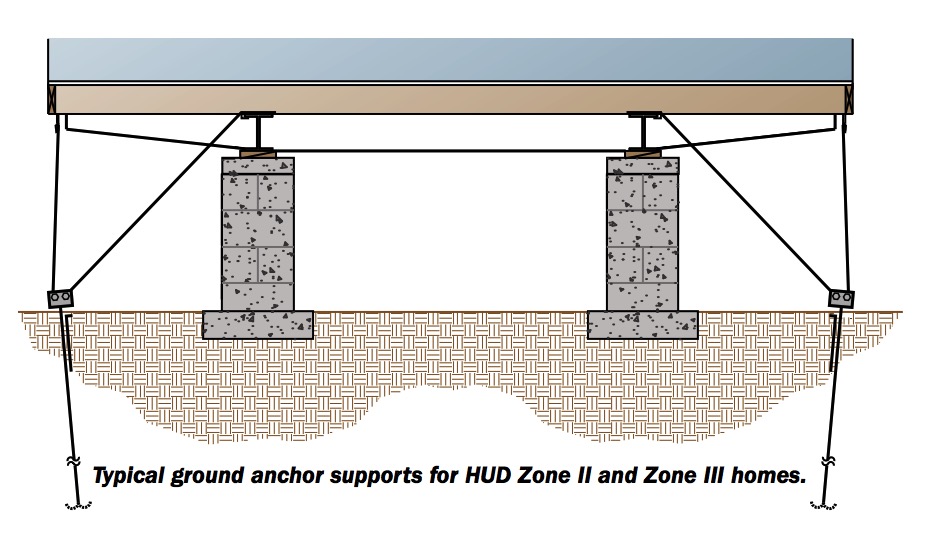



What Are The Tie Down Requirements For A Mobile Home
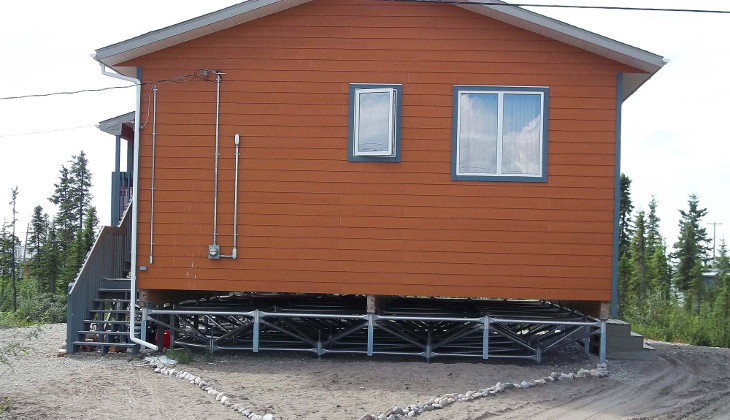



Mobile Home Anchors Enabling Your House To Stand Its Ground Against Natural Disasters
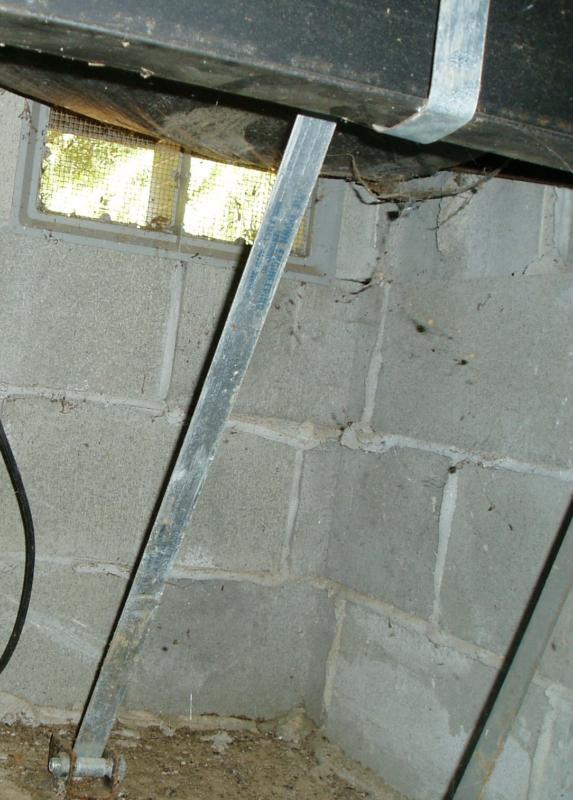



Home Inspection Bellingham King Of The House Tie Me Mobile Home Down Sport
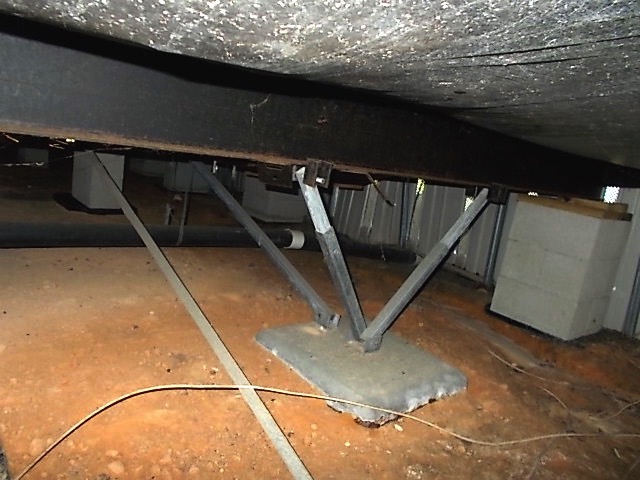



How Often Should Mobile Manufactured Home Foundation Tie Downs Be Checked



1
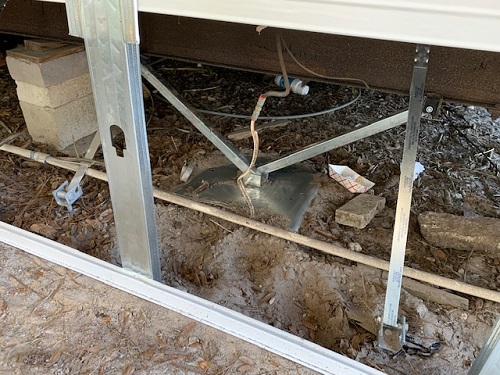



Mobile Home Engineering Foundation Certs 407 535 3195



Huduser Gov




Tie Downs For Manufactured Homes Internachi
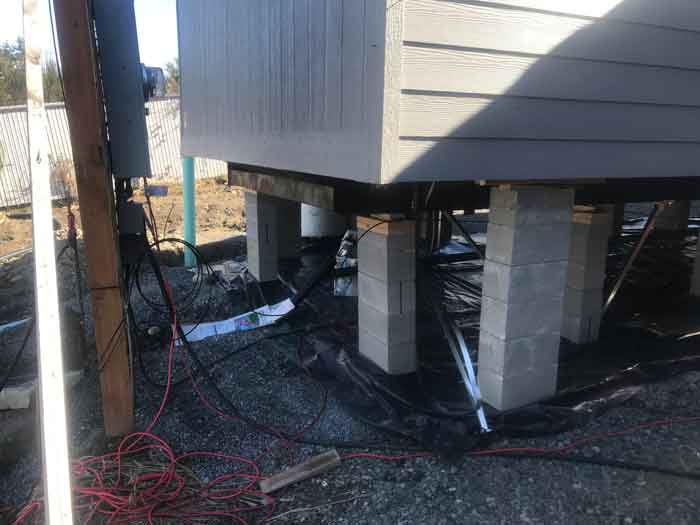



What Is Earthquake Tie Downs For Mobile Homes Duraskirt For Life




Manufactured Home Installation And Setup Mobile Home Living
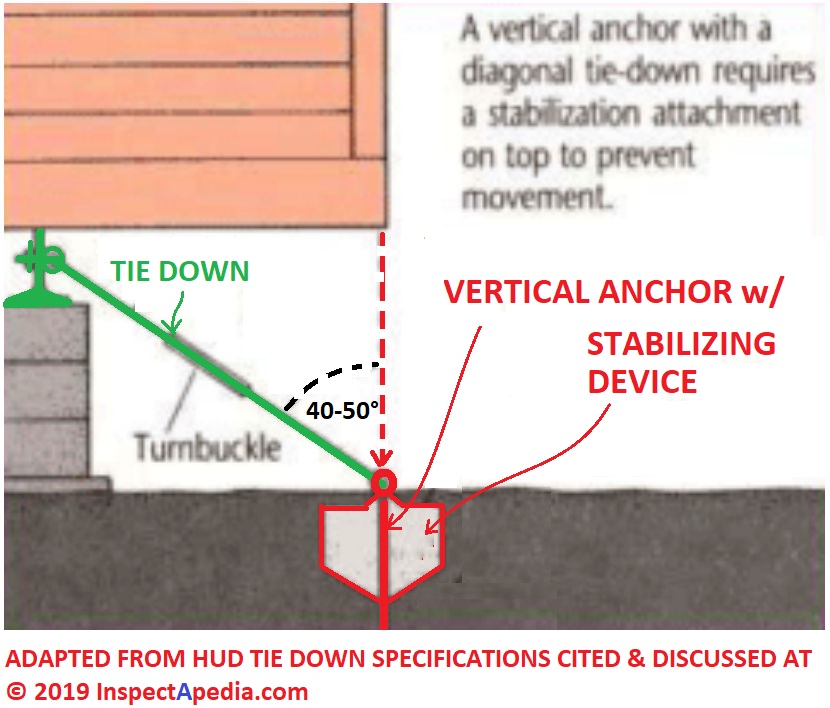



Mobile Home Tie Downs Anchors Stabilizing Systems Defects Commonly Found In The Stabilizing Systems Cables Tie Downs For Wind Storm Damage Resistance Of Mobile Homes Doublewides Mutiwides Trailers



How To Tie Down A Mobile Home Home Nation



Mobile Home Anchors Tie Downs Harris Reed Seiferth Insurance Group
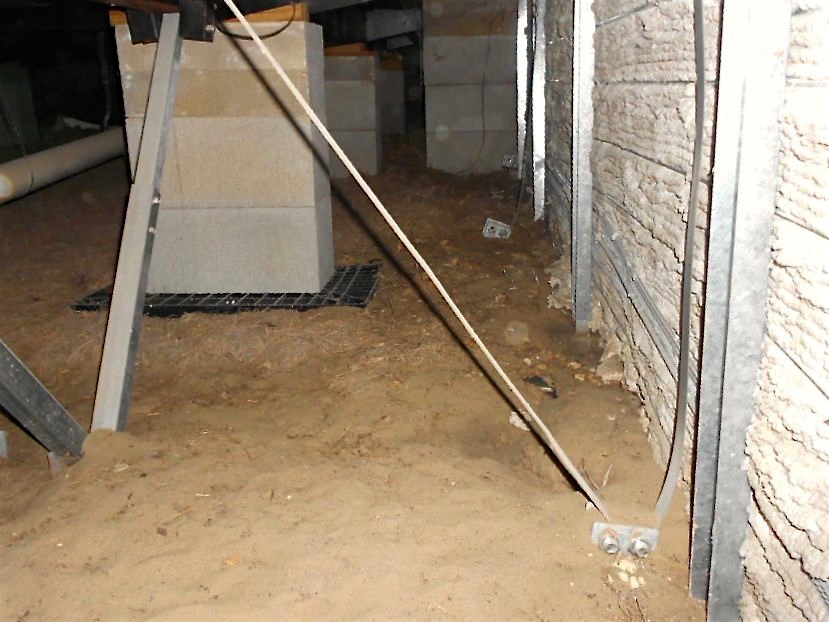



What Are The Tie Down Requirements For A Mobile Home




Installing Mobile Home Tie Down Strap Youtube
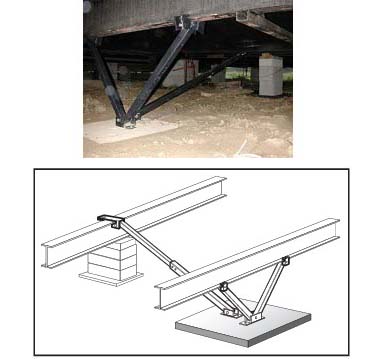



Foundation Systems
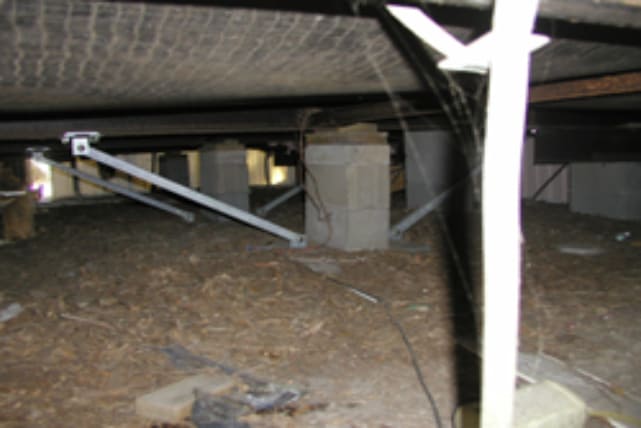



The 12 Most Common Problems With Older Mobile Homes Mobile Home Friend
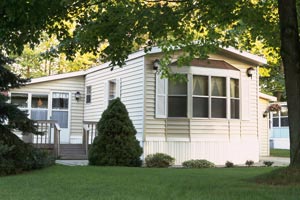



Mobile Home Anchors And Tie Downs Foremost Insurance Group
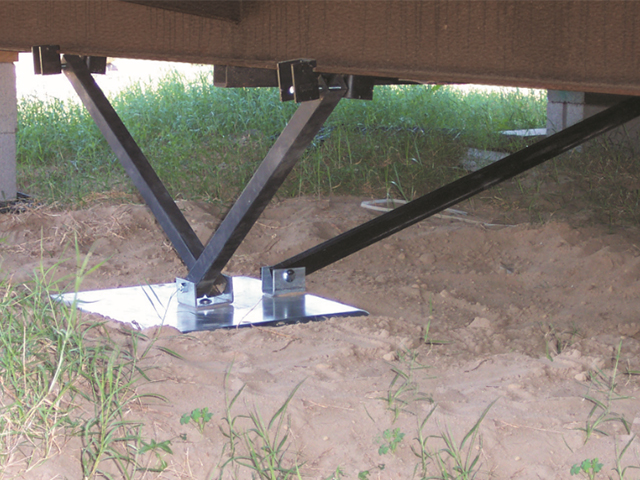



Foundation Stabilizing Systems Oliver Technologies Inc




Mobile Home Tie Down Inspection Waypoint Property Inspection
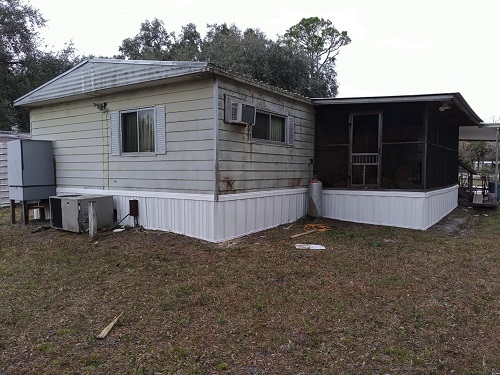



Mobile Home Engineering Foundation Certs 407 535 3195
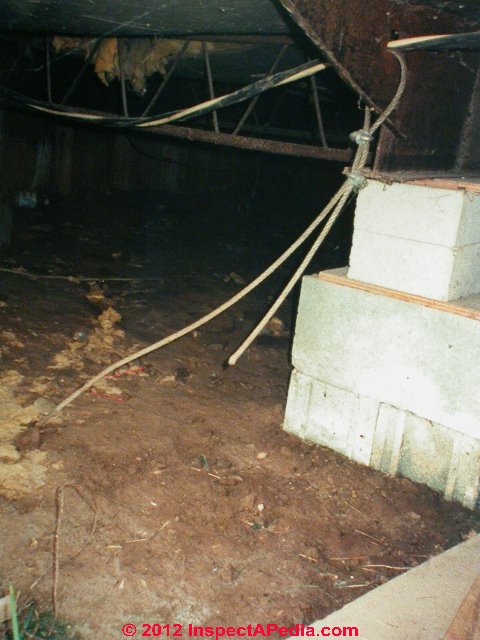



Mobile Home Tie Downs Anchors Stabilizing Systems Defects Commonly Found In The Stabilizing Systems Cables Tie Downs For Wind Storm Damage Resistance Of Mobile Homes Doublewides Mutiwides Trailers
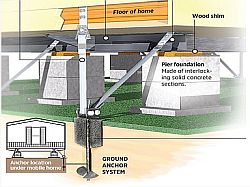



Mobile Home Tie Downs And Hurricane Anchors



Tie Downs For Your Mobile Home rp Mobile Home Insurance And Motorcycle Insurance From Foremost




Easiest Way To Anchor A Mobile Home Youtube
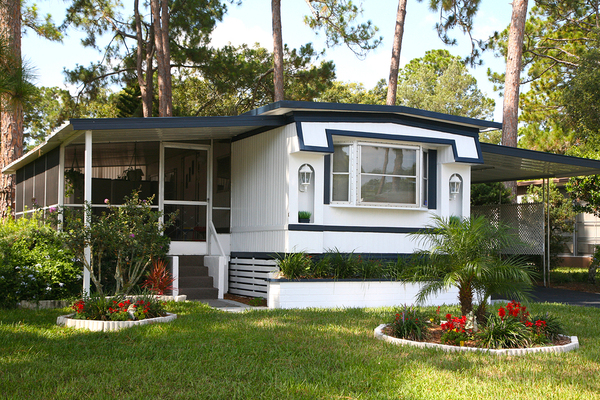



Here S How A Mobile Home Inspection Checklist Is Different Home Inspection Report



Fha Compliant And Non Compliant Mobile Home Anchors




Manufactured Homes Pse Consulting Engineers Inc




Replacing Tie Down Straps Sunset Mhs



Abilene Mobile Homes Anchors Set Up




Tie Downs For Manufactured Homes Internachi



0 件のコメント:
コメントを投稿